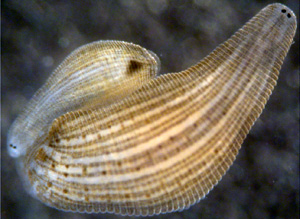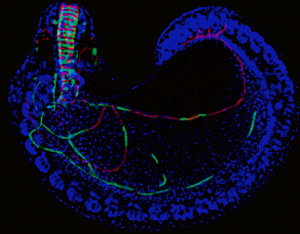

Leeches are distinguished from other annelids by anterior and posterior suckers used for locomotion and feeding – on blood or soft body parts of other animals. Helobdella robusta was chosen for whole genome sequencing because of its relatively small genome (~300 Mb) and its use as a model for annelid and lophotrochozoan development. Hermaphroditic like all clitellate annelids, Helobdella is capable of both cross- and self-fertilization. It is small (1-3 cm in length), and breeds year round in laboratory culture, feeding on small freshwater snails. Roughly synchronous batches up to about ~100 embryos can be easily pucked from the adult and cultured to juvenile stages in simple salt solutions, allowing access to all stages of development.
The Helobdella embryo is of use for several types of developmental studies, each of which will be greatly facilitated by the availability of genomic information.
First, it is a relatively tractable and well-studied representative of the spirally cleaving taxa (chiefly annelids, molluscs, and non-acoel flatworms). Thus, knowledge of Helobdella development provides an important point of comparison for elucidating the developmental changes associated with the evolution of body plans within this large and diverse assemblage of animals.
Second, the Helobdella embryo generates segments in anteroposterior progression by highly stereotyped lineages from a posterior growth zone comprising five bilateral pairs of individually identified, experimentally accessible segmentation stem cells called teloblasts. Segmentation is regarded as a key feature in the evolutionary success of annelids, arthropods and vertebrates, yet the evolutionary origin(s) of this trait remain in question. Analysis and comparison of axial development in segmented and unsegmented representatives of all three super-phyla (Deuterostomia, Ecdysozoa and Lophotrochozoa) are required to elucidate whether segmentation mechanisms among these phyla are homologous or the result of convergent evolution.
Third, while leeches generate exactly 32 segments during embryogenesis, and exhibit neither postembryonic segmentation nor the regeneration of segments in response to amputation, many oligochaete species exhibit both of these traits. The stereotyped patterns of cell division leading from the zygote to the five pairs of teloblasts and from each type of teloblast to stereotyped sets of segmentally iterated progeny are clearly homologous between leeches and oligochaetes. Thus, comparisons of Helobdella and regenerating oligochaetes such as Tubifex provide an excellent case study for studying the changes associated with the loss of regenerative capabilities, similar to that seen in the evolution of mammals from their vertebrate ancestors.
Fourth, while the hirudinid leech Hirudo medicinalis is among the best known systemsfor analyzing behavior in terms of the properties and connections of individually identified neurons, technical considerations largely prevent developmental studies of this species prior to the stage at which post-mitotic neurons are beginning to differentiate. Many neurons in Helobdella can be assigned clear homologs in Hirudo; thus Helobdella and other glossiphoniid genera such as Theromyzon and Haementeria canbe used to study the cell fate decisions leading to the specification of these well-characterized neurons.
Genome Reference(s)
Simakov O, Marletaz F, Cho SJ, Edsinger-Gonzales E, Havlak P, Hellsten U, Kuo DH, Larsson T, Lv J, Arendt D, Savage R, Osoegawa K, de Jong P, Grimwood J, Chapman JA, Shapiro H, Aerts A, Otillar RP, Terry AY, Boore JL, Grigoriev IV, Lindberg DR, Seaver EC, Weisblat DA, Putnam NH, Rokhsar DS
Insights into bilaterian evolution from three spiralian genomes.
Nature. 2013 Jan 24;493(7433):526-31. doi: 10.1038/nature11696
